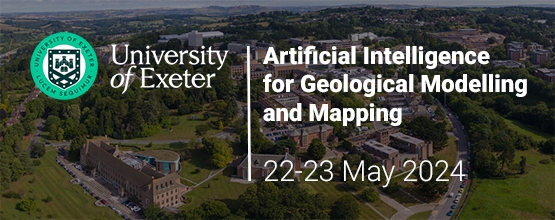Conference on Artificial Intelligence for Geological Modelling and Mapping
Discover the research work of our Ph.D. student Charlie Garayt on simulating 2D geological models for characterizing geomodeling uncertainty, combining a deep generative adversarial network (GAN) and a Bayesian approach.
Simulating horizontally infinite 2D geomodels with GANs
May 23, 2024 – 10:00 am – 10:20 am
Authors: C. GARAYT, P-M. Gibert, and J. Langanay (Geovariances); S. Blusseau (Mines Paris); N. Desassis and T. Romary (Mines Paris).
Abstract:
Structural geomodeling aims to produce geomodels consistent with field data. Field data, such as outcrops or drillholes, are sparse, come from different sources, and have different qualities. As a result, multiple geomodels may be consistent with the field data. Characterizing this geomodeling uncertainty is a major industrial challenge. One way to tackle this problem is by simulating geomodels.
This work aims to identify a distribution of geomodels that satisfies conditioning field data using a Bayesian framework, also known as a posterior distribution. The prior distribution, which is a distribution of all geomodels or unconditional geomodels, is usually unreachable in geology. Recent advances in deep learning allow access to a proxy of such a distribution. A deep generative adversarial network (GAN) is trained to define a prior distribution of geomodels. A modified Metropolis adjusted Langevin algorithm, a Markov chain Monte Carlo method, enables the acquisition of samples from the target posterior distribution. A previous work has already demonstrated the efficiency of this method.
However, the main limitation was the inability to simulate geomodels with sizes different from those in the training dataset. This study proposes a solution to this limitation through a GAN generator with padding-free convolutional architecture and adopting a patch-by-patch approach. To simulate a geomodel, a single latent grid is generated and sliced into small patches. This allows the GAN to generate parts of the geomodel, which are then assembled. Enlarging the latent grid enables the generation of larger geomodels, potentially infinite in size. The latent grid comprises three elements: a local noise, a global noise, and a structural dimension. The noises are generated from a Gaussian distribution. The local noise, which is different for each grid cell, allows local variations of the geomodel. The global noise, which is the same for the whole grid, allows to maintain a geological consistency between each part of the geomodel. The structural dimension, which is the normalized depth of the model, allows dealing with the depth non-stationarity. The method is memory scalable, as a large geomodel can be computed by multiple small patches and easily combined to form a potentially infinite-sized geomodel.
Finally, adapting the previous Bayesian conditioning method with the proposed GAN allows the simulation of infinite-sized geological models, such as outcrops or drillholes, consistent with conditioning data.
University of Exeter – Institute for Data Science and Artificial Intelligence
Visit the conference website →